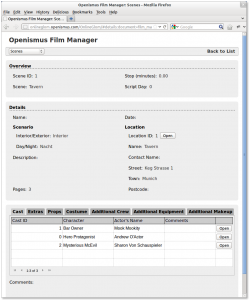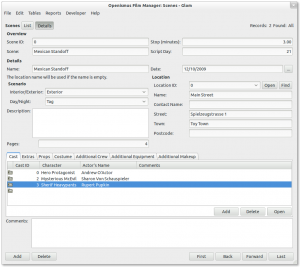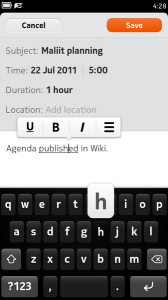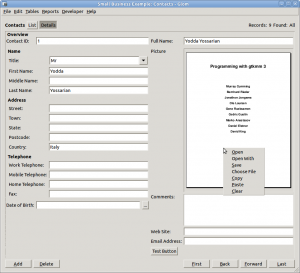Ben Konrath recently finished up a first real milestone in Online Glom development, and I have deployed it, with the example Glom files, on an Amazon EC2 instance. Online Glom is still a read-only UI, so you can’t edit data in the database, but I think it’s already useful for some situations. Well, I do want to add the quick search feature soon to really finish off the read-only functionality. Report-generation would be good too.
The Film Production Manager example is a fairly good example of the complex systems that Glom can support, without SQL and without programming.
Here’s a screenshot of the same thing in the desktop UI.
I have also deployed my old Debian Repository Analyzer, full of real data, so you can get a feel for navigating around the related records. I spent lots of time updating that for the latest python-apt API and libgda (with python) APIs, and it’s now in a gitorious project. Many thanks to Michael Vogt for his help with python-apt.
Now that David King has packaged java-libglom (as libjava-libglom-java) for Ubuntu Oneiric in the Openismus PPA, it’s really easy to work with the gwt-glom code on that distro.
What’s Next
This proves that GWT was a sane choice, though development has not been as quick as I’d hoped . But I don’t think a generic framework can ever be developed as rapidly as most data-driven web sites that start as quick hacks. The difficulties have shown that I was right to focus on a restricted set of functionality at first. You can get a sense of how development has progressed by looking at the gwt-glom commit log, though there’s lots of work in java-libglom too.
I now plan to take the development further myself. That’s a nice way to get more deeply reacquainted with Java and web development. It’s easier to hack on the project at this stage, before it gets huge, rather than trying to do this from scratch. Ben Konrath has already made the large architectural decisions so that I don’t have to. I’m even enjoying Eclipse, which is a much more pleasant experience with Java than with C++. Well, using the Eclipse IDE is still like shopping in a flea market but with Java you will quickly find useful things.
I plan to do things roughly in this order:
- Add the Quick Find feature, for searching. Update: Done
- Add report generation.
- Add print layout printing.
- Maybe investigate how to make theming via CSS easier.
- Allow editing of data. This will be a big task.
At the same time, I will play with avoiding the need for java-libglom’s JNI binding to the libglom C++ library. I would need to reimplement Glom document parsing in Java, but that would be easy as it’s just XML. But I would also need some replacement for GdaSqlBuilder, to build SQL queries without manually concatenating and escaping text.


 I recently pushed the
I recently pushed the 